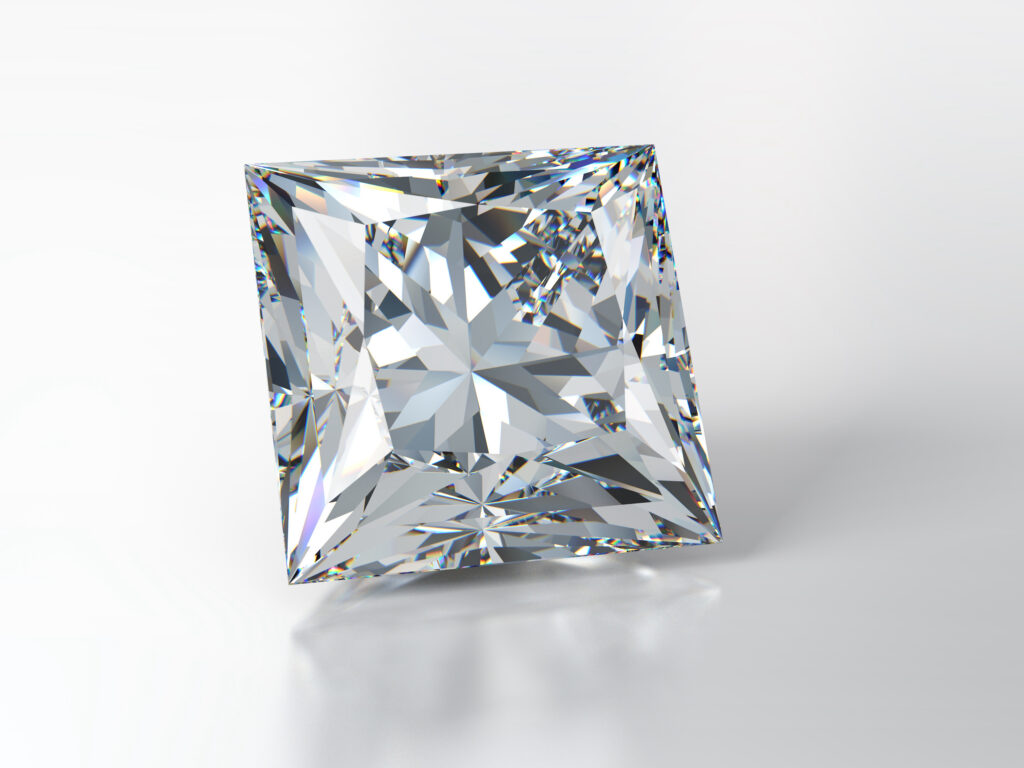Princess cut diamonds are a relatively modern concept, introducing an edgy, squarer cut into the jewelry world, but how well do these diamonds sparkle?
Princess cut diamonds certainly do sparkle, boasting a distinct brilliance that reflects light in a unique and beautiful way. However, they don’t sparkle quite as much as a round-cut diamond, which is considered the optimal cut for brilliance and sparkle.

Read on to learn more about princess cut diamonds, why they’re so popular, and how they’re made.
Only The Best For A Princess?
Although the princess cut diamond is a relatively new invention, it takes a lot of inspiration from the French cut diamond. This variant has existed since the 14th century, but it wasn’t until the 1960s that the princess cut allegedly first appeared.
The origins of this cut are somewhat disputed, with estimates placing its initial creation as early as the 1960s, but as late as the 1980s. It’s thought that the princess cut diamond was invented as a method for increasing brilliance and reducing the overall waste of cutting said diamond.
There’s a huge popularity drive behind the princess cut diamond that has never really faded. It makes for a modern and beautiful stone that simply dazzles, standing out vividly against its setting, an undeniably incredible gem that is instantly noticeable.
Reportedly, the cut was most likely created by a diamond cutter in London by the name of A. Nagy, in 1960. He allegedly created the pyramid-bottom, flat-top, squared-off design and christened it the princess cut, but this isn’t fully confirmed.
Despite the name, the princess cut diamond doesn’t actually bear any connection to a real princess. However, it does afford the cut a sense of style, grace, and class – traits that are synonymous with the idea of a physical princess.
That being said, with the cut boasting such immense popularity, it’s almost certain that princesses will come to wear such a cut diamond at some point in their lives.
An Extremely Attractive Example
Princess cut diamonds are prized for their brilliance – the way light is reflected through the stone itself. It produces and emits a charming sparkle that makes the gemstone infinitely more appealing to the consumer and wearer.
Traditionally, a princess cut diamond will act as a solitaire on a ring – most commonly, an engagement ring. They may be incorporated into a pavé design, featuring a path of smaller diamonds that sit beneath the main, larger stone.
Regardless of how they’re set, a princess cut diamond is a beloved stone that makes any piece of jewelry stand out. Owing to the nature of the cut, which roughly resembles an upside-down pyramid, the stone can weigh less but still look quite a decent size.
This is partly what contributes to the popularity of a princess cut stone. As there is a lower weight overall, the stone is naturally much more affordable when compared to a heavier diamond.
Furthermore, the cut is designed to work in such a way that the diamond cutter uses less of the rough diamond to make a princess cut. It works as it was designed in the first place – to serve as a more economical cut to traditional cuts.
But It Isn’t The Best
You could argue that if the princess cut diamond was to be the best diamond, it would be called the queen cut, or something similar. Unfortunately, the princess cut, while beautiful, isn’t considered to be the best cut available.
That prize is awarded to the simple yet elegant round-cut diamond. It’s otherwise known as the round brilliant cut, and while the princess cut diamond certainly does sparkle, its brilliance doesn’t come close to a round brilliant cut.
Although a princess cut and a round-cut diamond have the same amount of ‘facets’, the round-cut diamond simply reflects light in a better way. Although, they’re much less economical, and around sixty percent of a rough diamond is wasted when cutting a round brilliant variant.
That being said, the cut is more durable, so it’s likely a better option for the heavy-handed wearer. The sharper edges and corners on a princess cut diamond are somewhat susceptible to damaging quite easily, while the rounded edges of a round-cut diamond are more resilient.
Ultimately, it’s a choice that is best left decided by the consumer, and of course, the wearer. If there’s a little more leeway in the budget, then a round-cut diamond is the clear choice, but there’s certainly nothing wrong with a beautiful, princess-cut diamond.
If you’re eager to find out how much princess cut diamonds cost, you can read this article.
